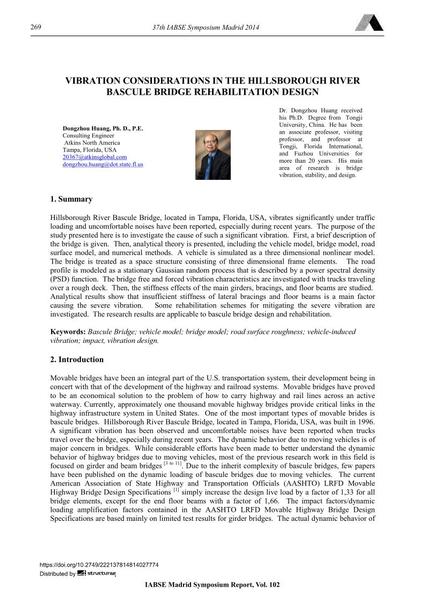Vibration Considerations in the Hillsborough River Bascule Bridge Rehabilitation Design

|
|
|||||||||||
Bibliographic Details
| Author(s): |
Dongzhou Huang
|
||||
|---|---|---|---|---|---|
| Medium: | conference paper | ||||
| Language(s): | English | ||||
| Conference: | IABSE Symposium: Engineering for Progress, Nature and People, Madrid, Spain, 3-5 September 2014 | ||||
| Published in: | IABSE Symposium Madrid 2014 | ||||
|
|||||
| Page(s): | 269-276 | ||||
| Total no. of pages: | 8 | ||||
| Year: | 2014 | ||||
| DOI: | 10.2749/222137814814027774 | ||||
| Abstract: |
Hillsborough River Bascule Bridge, located in Tampa, Florida, USA, vibrates significantly under traffic loading and uncomfortable noises have been reported, especially during recent years. The purpose of the study presented here is to investigate the cause of such a significant vibration. First, a brief description of the bridge is given. Then, analytical theory is presented, including the vehicle model, bridge model, road surface model, and numerical methods. A vehicle is simulated as a three dimensional nonlinear model. The bridge is treated as a space structure consisting of three dimensional frame elements. The road profile is modeled as a stationary Gaussian random process that is described by a power spectral density (PSD) function. The bridge free and forced vibration characteristics are investigated with trucks traveling over a rough deck. Then, the stiffness effects of the main girders, bracings, and floor beams are studied. Analytical results show that insufficient stiffness of lateral bracings and floor beams is a main factor causing the severe vibration. Some rehabilitation schemes for mitigating the severe vibration are investigated. The research results are applicable to bascule bridge design and rehabilitation. |
||||
| Keywords: |
bascule bridge impact bridge model vehicle model road surface roughness vehicle-induced vibration vibration design
|
||||

